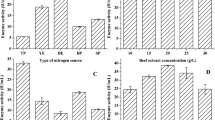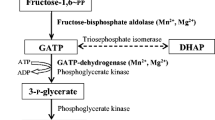Abstract
Inulin is a readily available feedstock for cost-effective production of biochemicals. To date, several studies have explored the production of bioethanol, high-fructose syrup and fructooligosaccharide, but there are no studies regarding the production of d-lactic acid using inulin as a carbon source. In the present study, chicory-derived inulin was used for d-lactic acid biosynthesis by Lactobacillus bulgaricus CGMCC 1.6970. Compared with separate hydrolysis and fermentation processes, simultaneous saccharification and fermentation (SSF) has demonstrated the best performance of d-lactic acid production. Because it prevents fructose inhibition and promotes the complete hydrolysis of inulin, the highest d-lactic acid concentration (123.6 ± 0.9 g/L) with a yield of 97.9 % was obtained from 120 g/L inulin by SSF. Moreover, SSF by L. bulgaricus CGMCC 1.6970 offered another distinct advantage with respect to the higher optical purity of d-lactic acid (>99.9 %) and reduced number of residual sugars. The excellent performance of d-lactic acid production from inulin by SSF represents a high-yield method for d-lactic acid production from non-food grains.






Similar content being viewed by others
References
Drumright RE, Gruber PR, Henton DE (2000) Polylactic acid technology. Adv Mater 12:1841–1846
Gross RA, Bhanu K (2002) Biodegradable polymers for the environment. Science 297:803–807
Lee JW, Kim HU, Choi S, Yi J, Lee SY (2011) Microbial production of building block chemicals and polymers. Curr Opin Biotechnol 22:758–767
Fukushima K, Chang YH, Kimura Y (2007) Enhanced stereocomplex formation of poly (l-lactic acid) and poly (d-lactic acid) in the presence of stereoblock poly (lactic acid). Macromol Biosci 7:829–835
Wang L, Zhao B, Li F, Xu K, Ma C, Tao F, Li Q, Xu P (2011) Highly efficient production of d-lactic acid by Sporolactobacillus sp. CASD with simultaneous enzymatic hydrolysis of peanut meal. Appl Microbiol Biotechnol 89:1009–1017
Abdel-Rahman MA, Tashiro Y, Sonomoto K (2013) Recent advances in lactic acid production by microbial fermentation processes. Biotechnol Adv 31:877–902
Zhang Y, Vadlani PV (2013) d-Lactic acid biosynthesis from biomass-derived sugars via Lactobacillus delbrueckii fermentation. Bioprocess Biosyst Eng 36:1897–1904
Mohamed Ali AR, Yukihiro T, Kenji S (2010) Lactic acid production from lignocellulose-derived sugars using lactic acid bacteria: overview and limits. J Biotechnol 156:286–301
Saha BC, Nichols NN, Qureshi N, Cotta MA (2011) Comparison of separate hydrolysis and fermentation and simultaneous saccharification and fermentation processes for ethanol production from wheat straw by recombinant Escherichia coli strain FBR5. Appl Microbiol Biotechnol 92:865–874
Tanaka T, Hoshina M, Tanabe S, Sakai K, Ohtsubo S, Taniguchi M (2006) Production of d-lactic acid from defatted rice bran by simultaneous saccharification and fermentation. Bioresour Technol 97:211–217
Kango N (2008) Production of inulinase using tap roots of dandelion (Taraxacum officinale) by Aspergillus niger. J Food Eng 85:473–478
Wang L, Xue Z, Bo Z, Bo Y, Ping X, Ma Y (2013) Jerusalem artichoke powder: a useful material in producing high-optical-purity l-lactic acid using an efficient sugar-utilizing thermophilic Bacilluscoagulans strain. Bioresour Technol 130:174–180
Matías J, González J, Royano L, Barrena RA (2011) Analysis of sugars by liquid chromatography-mass spectrometry in Jerusalem artichoke tubers for bioethanol production optimization. Biomass Bioenerg 35:2006–2012
Ricca E, Calabrò V, Curcio S, Iorio G (2009) Fructose production by chicory inulin enzymatic hydrolysis: a kinetic study and reaction mechanism. Process Biochem 44:466–470
Hong S-J, Kim HJ, Kim J-W, Lee D-H, Seo J-H (2015) Optimizing promoters and secretory signal sequences for producing ethanol from inulin by recombinant Saccharomyces cerevisiae carrying Kluyveromyces marxianus inulinase. Bioprocess Biosyst Eng 38:263–272
Singh RS, Dhaliwal R, Puri M (2007) Partial purification and characterization of exoinulinase from Kluyveromyces marxianus YS-1 for preparation of high-fructose syrup. J Microbiol Biotechnol 17:733–738
Kim H-C, Kim H-J, CHOI W-B, Nam S-W (2006) Inulooligosaccharide production from inulin by Saccharomyces cerevisiae strain displaying cell-surface endoinulinase. J Microbiol Biotechnol 16:360–367
Petrova P, Velikova P, Popova L, Petrov K (2015) Direct conversion of chicory flour into l-(+)-lactic acid by the highly effective inulinase producer Lactobacillus paracasei DSM 23505. Bioresour Technol 186:329–333
Dao TH, Zhang J, Bao J (2013) Characterization of inulin hydrolyzing enzyme(s) in commercial glucoamylases and its application in lactic acid production from Jerusalem artichoke tubers (Jat). Bioresour Technol 148C:157–162
Kalil SJ, Suzan R, Maugeri F, Rodrigues MI (2001) Optimization of inulinase production by Kluyveromyces marxianus using factorial design. Appl Biochem Biotechnol 94:257–264
Xu Y, Zheng Z, Xu Q, Yong Q, Ouyang J (2016) Efficient conversion of inulin to inulooligosaccharides through endoinulinase from Aspergillus niger. J Agr Food Chem 64:2612–2618
Prabhjot Kaur G, Rajesh Kumari M, Prabhjeet S (2006) Purification and properties of a heat-stable exoinulinase isoform from Aspergillus fumigatus. Bioresour Technol 97:894–902
Baston O, Neagu C, Bahrim G (2013) Establishing the optimum conditions for inulin hydrolysis by using commercial inulinase. Rev Chim 64:649–653
Benthin S, Villadsen J (1995) Production of optically pure d-lactic acid by Lactobacillus bulgaricus and purification by crystallisation and liquid/liquid extraction. Appl Microbiol Biotechnol 42:826–829
Grobben G, Van Casteren W, Schols H, Oosterveld A, Sala G, Smith M, Sikkema J, De Bont J (1997) Analysis of the exopolysaccharides produced by Lactobacillus delbrueckii subsp. bulgaricus NCFB 2772 grown in continuous culture on glucose and fructose. Appl Microbiol Biotechnol 48:516–521
Rault A, Bouix M, Béal C (2009) Fermentation pH influences the physiological-state dynamics of Lactobacillus bulgaricus CFL1 during pH-controlled culture. Appl Environ Microbiol 75:4374–4381
Tsuge Y, Kawaguchi H, Sasaki K, Tanaka T, Kondo A (2014) Two-step production of d-lactic acid from mixed sugars by growing and resting cells of metabolically engineered Lactobacillus plantarum. Appl Microbiol Biotechnol 98:4911–4918
Singhvi M, Joshi D, Adsul M, Varma A, Gokhale D (2010) d-(−)-l actic acid production from cellobiose and cellulose by Lactobacillus lactis mutant RM2-24. Green Chem 12:1106–1109
Zhao B, Wang L, Li F, Hua D, Ma C, Ma Y, Xu P (2010) Kinetics of d-lactic acid production by Sporolactobacillus sp. strain CASD using repeated batch fermentation. Bioresour Technol 101:6499–6505
Rhee S, Pack M (1980) Effect of environmental pH on fermentation balance of Lactobacillus bulgaricus. J Bacteriol 144:217–221
John RP, Anisha G, Nampoothiri KM, Pandey A (2009) Direct lactic acid fermentation: focus on simultaneous saccharification and lactic acid production. Biotechnol Adv 27:145–152
Lin Y, Tanaka S (2006) Ethanol fermentation from biomass resources: current state and prospects. Appl Microbiol Biotechnol 69:627–642
Yáñez R, Alonso JL, Parajó JC (2005) d-Lactic acid production from waste cardboard. J Chem Technol Biotechnol 80:76–84
Okano K, Zhang Q, Shinkawa S, Yoshida S, Tanaka T, Fukuda H, Kondo A (2009) Efficient production of optically pure d-lactic acid from raw corn starch by using a genetically modified l-lactic acid dehydrogenase gene-deficient and α-amylase-secreting Lactobacillus plantarum strain. Appl Environ Microbiol 75:462–467
Nakano S, Ugwu CU, Tokiwa Y (2012) Efficient production of d-(−)-lactic acid from broken rice by Lactobacillus delbrueckii using Ca(OH)2 as a neutralizing agent. Bioresour Technol 104:791–794
Acknowledgments
This study was supported by the Jiangsu Co-Innovation Center of Efficient Processing and Utilization of Forest Resources, Nanjing Forestry University, the National Natural Science Foundation of China (51561145015), the Key Research and Development Program of Jiangsu Province of China (BF2015007).The authors are also grateful to the Priority Academic Program Development of Jiangsu Higher Education Institutions (PAPD).
Author information
Authors and Affiliations
Corresponding author
Electronic supplementary material
Below is the link to the electronic supplementary material.
Rights and permissions
About this article
Cite this article
Xu, Q., Zang, Y., Zhou, J. et al. Highly efficient production of d-lactic acid from chicory-derived inulin by Lactobacillus bulgaricus . Bioprocess Biosyst Eng 39, 1749–1757 (2016). https://doi.org/10.1007/s00449-016-1650-5
Received:
Accepted:
Published:
Issue Date:
DOI: https://doi.org/10.1007/s00449-016-1650-5




